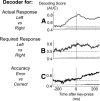Decoding the dynamics of action, intention, and error detection for conscious and subliminal stimuli
- PMID: 24453309
- PMCID: PMC5635966
- DOI: 10.1523/JNEUROSCI.2465-13.2014
Decoding the dynamics of action, intention, and error detection for conscious and subliminal stimuli
Abstract
How do we detect our own errors, even before we receive any external feedback? One model hypothesizes that error detection results from the confrontation of two signals: a fast and unconscious motor code, based on a direct sensory-motor pathway; and a slower conscious intention code that computes the required response given the stimulus and task instructions. To test this theory and assess how the chain of cognitive processes leading to error detection is modulated by consciousness, we applied multivariate decoding methods to single-trial magnetoencephalography and electroencephalography data. Human participants performed a fast bimanual number comparison task on masked digits presented at threshold, such that about half of them remained unseen. By using both erroneous and correct trials, we designed orthogonal decoders for the actual response (left or right), the required response (left or right), and the response accuracy (correct or incorrect). While perceptual stimulus information and the actual response hand could be decoded on both conscious and non-conscious trials, the required response could only be decoded on conscious trials. Moreover, whether the current response was correct or incorrect could be decoded only when the target digits were conscious, at a time and with a certainty that varied with the amount of evidence in favor of the correct response. These results are in accordance with the proposed dual-route model of conscious versus nonconscious evidence accumulation, and suggest that explicit error detection is possible only when the brain computes a conscious representation of the desired response, distinct from the ongoing motor program.
Keywords: Action; Consciousness; Error; Intention; MEEG.
Figures







References
-
- Chang C, Lin C. LIBSVM: a library for support vector machines. ACM TIST. 2011;2 doi: 10.1145/1961189.1961199. article 27. - DOI
Publication types
MeSH terms
Grants and funding
LinkOut - more resources
Full Text Sources
Other Literature Sources
